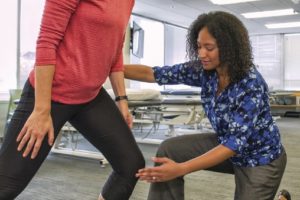Improve Fibromyalgia with Tai Chi
By John M. de Castro, Ph.D.
“Compared with patients who received wellness education and stretching exercises, those who practiced tai chi saw their fibromyalgia become much less severe. They also slept better, felt better, had less pain, had more energy, and had better physical and mental health.” – Chenchen Wang
Fibromyalgia is a mysterious disorder whose causes are unknown. It is very common affecting over 5 million people in the U.S., about 2% of the population with about 7 times more women affected than men. It is characterized by widespread pain, abnormal pain processing, sleep disturbance, and fatigue that lead to psychological distress. Fibromyalgia may also have morning stiffness, tingling or numbness in hands and feet, headaches, including migraines, irritable bowel syndrome, sleep disturbances, thinking and memory problems, and painful menstrual periods. The symptoms are so severe and debilitating that about half the patients are unable to perform routine daily functions and about a third have to stop work. Although it is not itself fatal, suicide rates are higher in fibromyalgia sufferers.
There are no completely effective treatments for fibromyalgia. Drugs and lifestyle changes are recommended but produce only limited symptomatic relief but also can produce unwanted side effects. Alternatively, mindfulness practices have been shown to be effective in reducing pain from fibromyalgia. Tai Chi is an ancient mindfulness practice involving slow prescribed movements. It is gentle and completely safe, can be used with the elderly and sickly, is inexpensive to administer, can be performed in groups or alone, at home or in a facility or even public park, and can be quickly learned. In addition, it can also be practiced in social groups without professional supervision. This can make it fun, improving the likelihood of long-term engagement in the practice. In addition, Tai Chi has been shown to reduce pain in patients with spinal cord injury. Hence, Tai Chi may be an excellent treatment for the symptoms of fibromyalgia.
In today’s Research News article “A randomized controlled trial of 8-form Tai chi improves symptoms and functional mobility in fibromyalgia patients.” See summary below or view the full text of the study at: https://www.ncbi.nlm.nih.gov/pmc/articles/PMC5571653/, Jones and colleagues recruited fibromyalgia sufferers and randomly assigned them to either practice Tai Chi or receive education on fibromyalgia from physicians, dieticians, and counselors for 90 minutes, twice a week, for 12 weeks. Homework and home practice was also prescribed. The participants were measured before and after the 12-week treatment period for fibromyalgia impact, including fatigue, morning tiredness, stiffness, depression, anxiety, work ability, and physical function
They found that the Tai Chi group in comparison to baseline and the education group had significant decreases in fibromyalgia impact, pain, sleep quality, self-efficacy, functional mobility, and balance. There were also significant reductions in pain, and improvements in sleep quality, self-efficacy, functional mobility, and balance. Importantly, none of the participants dropped out from the Tai Chi group. Hence, Tai Chi was found to be well tolerated and acceptable, and to produce clinically significant improvements in the symptoms of fibromyalgia.
Tai Chi can significantly improve the suffering from fibromyalgia while being acceptable for practice for patients in pain. It has no known negative side effects, is inexpensive and convenient to practice, and can be practiced alone or in groups. It appears to not only improve the psychological symptoms that can be produced by other mindfulness practices, but can also improve physical mobility including balance. Hence, Tai Chi would appear to be a nearly ideal treatment for fibromyalgia, either alone or in combination with other treatments.
So, improve fibromyalgia with Tai Chi.
“Aside from reductions in pain, patients in the tai chi group reported improvements in mood, quality of life, sleep, self-efficacy and exercise capacity. The potential efficacy and lack of adverse effects now make it reasonable for physicians to support patients’ interest in exploring these types of exercises, even if it is too early to take out a prescription pad and write ‘tai chi,’” – Gloria Yeh
CMCS – Center for Mindfulness and Contemplative Studies
This and other Contemplative Studies posts are also available on Google+ https://plus.google.com/106784388191201299496/posts and on Twitter @MindfulResearch
Study Summary
Jones, K. D., Sherman, C. A., Mist, S. D., Carson, J. W., Bennett, R. M., & Li, F. (2012). A randomized controlled trial of 8-form Tai chi improves symptoms and functional mobility in fibromyalgia patients. Clinical Rheumatology, 31(8), 1205–1214. http://doi.org/10.1007/s10067-012-1996-2
Abstract
Previous researchers have found that 10-form Tai chi yields symptomatic benefit in patients with fibromyalgia (FM). The purpose of this study was to further investigate earlier findings and add a focus on functional mobility. We conducted a parallel-group randomized controlled trial FM-modified 8-form Yang-style Tai chi program compared to an education control. Participants met in small groups twice weekly for 90 min over 12 weeks. The primary endpoint was symptom reduction and improvement in self-report physical function, as measured by the Fibromyalgia Impact Questionnaire (FIQ), from baseline to 12 weeks. Secondary endpoints included pain severity and interference (Brief Pain Inventory (BPI), sleep (Pittsburg sleep Inventory), self-efficacy, and functional mobility. Of the 101 randomly assigned subjects (mean age 54 years, 93 % female), those in the Tai chi condition compared with the education condition demonstrated clinically and statistically significant improvements in FIQ scores (16.5 vs. 3.1, p=0.0002), BPI pain severity (1.2 vs. 0.4, p=0.0008), BPI pain interference (2.1 vs. 0.6, p=0.0000), sleep (2.0 vs. −0.03, p=0.0003), and self-efficacy for pain control (9.2 vs. −1.5, p=0.0001). Functional mobility variables including timed get up and go (−.9 vs. −.3, p=0.0001), static balance (7.5 vs. −0.3, p= 0.0001), and dynamic balance (1.6 vs. 0.3, p=0.0001) were significantly improved with Tai chi compared with education control. No adverse events were noted. Twelve weeks of Tai chi, practice twice weekly, provided worthwhile improvement in common FM symptoms including pain and physical function including mobility. Tai chi appears to be a safe and an acceptable exercise modality that may be useful as adjunctive therapy in the management of FM patients.
